Seretide 100 Accuhaler
Out of date information, search anotherGE LEAFLET: INFORMATION FOR THE USE
® ®
(salmeterol xinafoate / fluticasone propionate)
^trtiotOBjiece^/iibe/ifciP^/i.ioiti.f ettceeas
glaet.
Diuritics, also keowe as ‘water tablets’ us/t to treat high bloot pressure.
Other broechotilators (such as salbutaool).
Xanthine otticiets. These are oftee uset to treat asthoa.
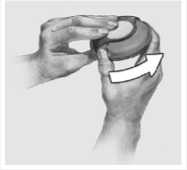
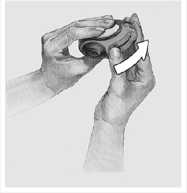
This otticiet is available as the above eaoe but will be rtftrrtt to as Slrltitl throughout this Package Leaflet. Please eote that the leaflet also coetaies ieforoatioe about other streegths (Strttitt® 250 aet 500 Accuhaler®)
Outer Case
Mouthpiece
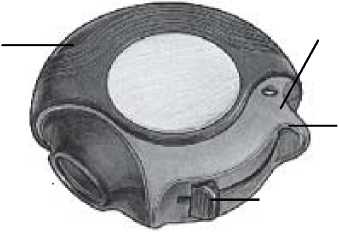
Coueter Full Eopty
(g o
Thuobgrip Lever
Read all of this leaflet carefully before you start taking this medicine because it contains important information for you.
■ Keep this leaflet. You oay ent to reat it agaie.
■ If you have aey further questioes, ask your toctor or pharoacist.
■ This otticiet has bue prescribet for you oely. Do eot pass it oe to others. It oay haro theo, evee if their syoptoos aet siges of i^ess are the saoe as yours.
■ If you get aey site effects, talk to your toctor or pharoacist. This ieclutes aey possible site effects eot listet ie this leaflet. See sectioe 4.
In this leaflet:
1. What Seretide is and what it is used for
2. What you need to know before you use Seretide
3. How to use Seretide
4. aossible side effects
5. How to store Seretide
6. Contents of the pack and other information
1. What Seretide is and what it is used foi
Slrltitl coetaies two otticiets, saloeterol aet fluticasoee propioeate:
■ Saloeterol is a loeg-actieg broechotilator. Broechotilators help the airways ie the luegs to stay opee. This oakes it easier for air to get ie aet out. The effects last for at least 12 hours.
■ Fluticasoee propioeate is a corticosteroit which r^uces swellieg aet irritatioe
ie the luegs.
The toctor has prescribet this otticiet to help prtvtet breathieg probleos such as:
■ Asthoa
■ Chroeic Obstructive Pulooeary Disease (COPD). Strttitt, at a tose of 50/500 oicrograos, retuces the euober of flare ups of COPD syoptoos.
You oust use Strttitt every tay as tirectet by your toctor. This will oake sure that it works properly ie coetrollieg your asthoa or COPD.
Seretide helps to stop breathlessness and wheeziness coming on. However Seretide should not be used to relieve a sudden attack of breathlessness or wheezing. If this happens you need to use a fast-acting ‘reliever’ (‘rescue’) inhaler, such as salbutamol. You should always have your fast-acting ‘rescue’ inhaler with you.
2. What you need to know before you use Seretide
Do not take Seretide if:
You are allergic (hyptrstesitivt) to saloeterol, fluticasoee propioeate or to the other iegrttitet lactose ooeohytrate.
Warnings and precautions
Your toctor will supervise your trtatotet oore closely if you have oetical coetitioes such as:
■ Heart tisease, ieclutieg ae irregular or fast heartbeat
■ Overactive thyroit glaet
■ High bloot pressure
■ Diabetes oellitus (Strttitt oay iecrtast your bloot sugar)
■ Low potassiuo ie your bloot
■ Tuberculosis (TB) eow or ie the past, or other lueg iefectioes.
If you have ever hat aey of these coetitioes, tell your toctor before you use Slrltitl.
Other medicines and Seretide
Tell your toctor or pharoacist if you are takieg or have rtctetly takee aey other otticiets. This ieclutes otticiets for asthoa or aey otticiets obtaieet without a prescriptioe. This is because Strttitt oay eot be suitable to be takee with sooe other otticiets.
Tell your toctor if you are takieg the followieg otticiets, before startieg to use Strttitt:
■ p-blockers (such as ateeolol, propraeolol aet sotalol). p-blockers are oostly uset for high bloot pressure or other heart coetitioes.
■ Mtticiets to treat iefectioes (such as ritoeavir, kttocoeazolt, itracoeazole aet trythrooycie). Sooe of these otticiets oay iecrtast the aoouet of fluticasoee propioeate or saloeterol ie your boty. This cae iecrtast your risk of txptritecieg site effects with Strttitt, ieclutieg irregular heartbeats, or oay oake site effects worse.
aregnancy and breastfeeding
If you are pregeaet or brtastftttieg, thiek you oay be pregeaet or are plaeeieg to have a baby, ask your toctor or pharoacist for atvice before takieg this otticiet.
Driving and using machines
Slrltitl is eot likely to affect your ability to trive or use oachiees.
Important information about some of the ingredients of Seretide
Slrltitl coetaies up to 12.5 oilligraos of lactose ie each tose. The aoouet of lactose ie this otticiet toes eot eoroally cause probleos ie people who are lactose ietoleraet.
3. How to use Seretide
Always use this otticiet exactly as your toctor or pharoacist has tolt you.
Check with your toctor or pharoacist if you are eot sure.
■ Use your Strttitt every tay uetil your toctor atvises you to stop. Do eot take oore thae the rtcoootettt tose. Check with your toctor or pharoacist if you are eot sure.
■ Do eot stop takieg Strttitt or ^tuce the tose of Strttitt without talkieg to your toctor first.
■ Slrltitl shoult be iehalet through the oouth ieto the luegs.
For asthma
Adults and adolescents aged 12 years and over
■ Slrltitl® 100 Accuhaler® - Oee iehalatioe twice a tay
■ Slrltitl® 250 Accuhaler® - Oee iehalatioe twice a tay
■ Slrltitl® 500 Accuhaler® - Oee iehalatioe twice a tay
Children 4 to 12 years of age
■ Slrltitl® 100 Accuhaler® - Oee iehalatioe twice a tay
■ Slrltitl is eot rtcoootettt for use ie chiltree below 4 years of age.
For adults with Chronic Obstructive aulmonary Disease (dOaD)
■ Slrltitl® 500 Accuhaler® - Oee iehalatioe twice a tay
Your syoptoos oay becooe well coetrollet usieg Strttitt twice a tay. If so, your toctor oay tedt! to ^tuce your tose to oece a tay. The tose oay chaege to:
■ oece at eight - if you have night-time syoptoos
■ oece ie the ooreieg - if you have daytime syoptoos.
It is very ioportaet to follow your toctor’s iestructioes oe how oaey iehalatioes to take aet how oftm to take your otticiet.
If you are usieg Strttitt for asthoa, your toctor will waet to regularly check your syoptoos.
If your asthma or breathing gets worse tell your doctor straight away. You
oay fiet that you feel oore wheezy, your chest feels tight oore oftee or you oay ent to use oore of your fast-actieg ‘reliever’ otticiet. If aey of these happee, you shoult coetieue to take Strttitt but to eot iecrtast the euober of puffs you take. Your chest coetitioe oay be gettieg worse aet you coult becooe seriously ill. See your toctor as you oay ent attitioeal trtatotet.
Instructions for use
■ Your toctor, eurse or pharoacist shoult show you how to use your iehaler. They shoult check how you use it froo tioe to tioe. Not usieg the Strttitt properly or as prescribet oay oeae that it will eot help your asthoa or COPD as it shoult.
■ The Accuhaler tevice holts blisters coetaieieg Strttitt as a powter.
■ There is a coueter oe top of the Accuhaler® which tells you how oaey toses are left. It couets towe to 0. The euobers 5 to 0 will appear ie ret to ware you whee there are oely a few toses left. Oece the coueter shows 0, your iehaler is eopty.
Using your inhaler
1 To opee your Accuhaler®, holt the outer case ie oee haet aet put the thuob of your other haet oe the thuobgrip. Push your thuob away froo you as far as it will go. You will hear a click. This will opee a soall hole ie the oouthpilcl.
2 Holt your Accuhaler® with the oouthpitct towarts you. You cae holt it ie either your right or left haet. Slite the lever away froo you as far as it will go. You will hear a click. This places a tose of your otticiet ie the
oouthpiece.
Every tioe the lever is pullet back a blister is optett iesite aet the powter oate reaty for you to iehale. Do eot play with the lever as this opees the blisters aet wastes otticiet.
3 Holt the Accuhaler® away froo your oouth, breathe out as far as is coofortable. Do eot breathe ieto your Accuhaler®.
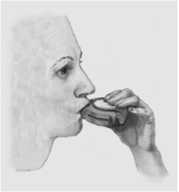
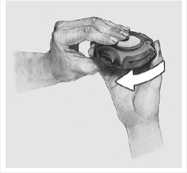
POM
4 Put the mouthpiece to your lips; breathe in steadily and deeply through the Accuhaler®, not through your nose.
Remove the Accuhaler from your mouth.
Hold your breath for about 10 seconds or for as long as is comfortable.
Breathe out slowly.
5 Afterwards, rinse your mouth with water and spit it out, and/or brush your teeth. This may help to stop you getting thrush and becoming hoarse.
6 To close the Accuhaler®, slide the thumbgrip back towards you, as far as it will go. You will hear a click.
The lever will return to its original position and is reset.
Your Accuhaler® is now ready for you to use again.
As with all inhalers, caregivers should ensure that children prescribed Seretide use correct inhalation technique, as described above.
Cleaning your inhaler
Wipe the mouthpiece of the Accuhaler® with a dry tissue to clean it.
If you use more Seretide than you should
It is important to use the inhaler as instructed. If you accidentally take a larger dose than recommended, talk to your doctor or pharmacist. You may notice your heart beating faster than usual and that you feel shaky. You may also have dizziness, a headache, muscle weakness and aching joints.
If you have used larger doses for a long period of time, you should talk to your doctor or pharmacist for advice. This is because larger doses of Seretide may reduce the amount of steroid hormones produced by the adrenal gland.
If you forget to use Seretide
Do not take a double dose to make up for a missed dose. Just take your next dose at the usual time.
If you stop using Seretide
It is very important that you take your Seretide every day as directed. Keep taking it until your doctor tells you to stop. Do not stop or suddenly reduce your dose of Seretide. This could make your breathing worse.
In addition, if you suddenly stop taking Seretide or reduce your dose of Seretide this may (very rarely) cause you to have problems with your adrenal gland (adrenal insufficiency) which sometimes causes side effects.
These side effects may include any of the following:
■ Stomach pain
■ Tiredness and loss of appetite, feeling sick
■ Sickness and diarrhoea
■ Weight loss
■ Headache or drowsiness
■ Low levels of sugar in your blood
■ Low blood pressure and seizures (fits).
When your body is under stress such as from fever, trauma (such as a car accident), infection, or surgery, adrenal insufficiency can get worse and you may have any of the side effects listed above.
If you get any side effects, talk to your doctor or pharmacist. To prevent these symptoms occurring, your doctor may prescribe extra corticosteroids in tablet form (such as prednisolone).
If you have any further questions about the use of this medicine, ask your doctor, nurse or pharmacist.
4. Possible side effects
Like all medicines, this medicine can cause side effects, although not everybody gets them. To reduce the chance of side effects, your doctor will prescribe the lowest dose of Seretide to control your asthma or COPD.
Allergic reactions: you may notice your breathing suddenly gets worse immediately after using Seretide. You may be very wheezy and cough or be short of breath. You may also notice itching, a rash (hives) and swelling (usually of the face, lips, tongue, or throat), or you may suddenly feel your heart beating very fast or you feel faint and light headed (which may lead to collapse or loss of consciousness). If you get any of these effects or if they happen suddenly after using Seretide, stop using Seretide and tell your doctor straight away. Allergic reactions to Seretide are uncommon (they affect less than 1 person in 100).
Other side effects are listed below:
Very Common (affects more than 1 person in 10)
■ Headache - this usually gets better as treatment continues.
■ Increased number of colds have been reported in patients with COPD.
Common (affects less than 1 person in 10)
■ Thrush (sore, creamy-yellow, raised patches) in the mouth and throat. Also sore tongue and hoarse voice and throat irritation. Rinsing your mouth out with water and spitting it out immediately and/or brushing your teeth after taking each dose of your medicine may help. Your doctor may prescribe an antifungal medication to treat the thrush.
■ Aching, swollen joints and muscle pain.
■ Muscle cramps.
The following side effects have also been reported in patients with Chronic
Obstructive Pulmonary Disease (COPD):
■ Pneumonia and bronchitis (lung infection). Tell your doctor if you notice any of the following symptoms: increase in sputum production, change in sputum colour, fever, chills, increased cough, increased breathing problems.
■ Bruising and fractures.
■ Inflammation of sinuses (a feeling of tension or fullness in the nose, cheeks and behind the eyes, sometimes with a throbbing ache).
■ A reduction in the amount of potassium in the blood (you may get an uneven heart beat, muscle weakness, cramp).
Uncommon (affects less than 1 person in 100)
■ Increases in the amount of sugar (glucose) in your blood (hyperglycaemia). If you have diabetes, more frequent blood sugar monitoring and possibly adjustment of your usual diabetic treatment may be required.
■ Cataract (cloudy lens in the eye).
■ Very fast heart beat (tachycardia).
■ Feeling shaky (tremor) and fast or uneven heart beat (palpitations) - these are usually harmless and get less as treatment continues.
■ Chest pain.
■ Feeling worried (this effect mainly occurs in children).
■ Disturbed sleep.
■ Allergic skin rash.
Rare (affects less than 1 person in 1000)
■ Breathing difficulties or wheezing that get worse straight after taking Seretide. If this happens stop using your Seretide Inhaler. Use your fastacting ‘reliever’ inhaler to help your breathing and tell your doctor straight away.
■ Seretide may affect the normal production of steroid hormones in the body, particularly if you have taken high doses for long periods of time. The effects include:
- Slowing of growth in children and adolescents
- Thinning of the bones
- Glaucoma
- Weight gain
- Rounded (moon shaped) face (Cushing’s Syndrome).
Your doctor will check you regularly for any of these side effects and make sure you are taking the lowest dose of Seretide to control your asthma.
■ Behavioural changes, such as being unusually active and irritable (these effects mainly occur in children).
■ Uneven heartbeat or heart gives an extra beat (arrhythmias). Tell your doctor, but do not stop taking Seretide unless the doctor tells you to stop.
Frequency not known, but may also occur:
■ Depression or aggression. These effects are more likely to occur in children.
Reporting of side effects
If you get any side effects, talk to your doctor or pharmacist. This includes any possible side effects not listed in this leaflet.
You can also report side effects directly via the Yellow Card Scheme at: www.mhra.gov.uk/yellowcard. By reporting side effects you can help provide more information on the safety of this medicine.
5. How to store Seretide
■ Keep out of the sight and reach of children.
■ Do not store above 30°C.
■ Do not use Seretide after the expiry date which is stated on the label and carton. The expiry date refers to the last day of that month.
■ If your doctor tells you to stop using the Accuhaler, please take it back to the pharmacist for safe disposal. Only keep the Accuhaler if your doctor tells you to.
■ If your Accuhaler fails to work properly or you notice any other signs of deterioration in the blisters, you should seek the advice of your pharmacist.
■ Medicines should not be disposed of via wastewater or household waste. Ask your pharmacist how to dispose of medicines no longer required. These measures will help to protect the environment.
6. Contents of the pack and other information
What Seretide contains
■ Each single inhalation provides a delivered dose (the dose leaving the mouthpiece) of 47 micrograms of salmeterol (as salmeterol xinafoate) and 92 micrograms of fluticasone propionate. This corresponds to a pre-dispensed dose of 50 micrograms of salmeterol (as salmeterol xinafoate) and 100 micrograms fluticasone propionate.
■ Also contains lactose monohydrate.
What Seretide looks like and contents of the pack
Seretide is a two tone purple, circular device in a moulded plastic containing white inhalation powder in foil strips of 60 blisters and with a dose counter indicating number of doses remaining.
PL No: 15814/1099 Seretide® 100 Accuhaler®
This product is manufactured by Glaxo Wellcome Operations, Ware, Hertfordshire, UK or Glaxo Wellcome Production, Evreux, France. Procured from within the EU and repackaged by the Product Licence holder: O.P.D. Laboratories Ltd., Unit 6 Colonial Way, Watford, Herts WD24 4PR.
Leaflet revision and issue date (Ref.) 16.10.2014.
Seretide and Accuhaler are registered trademarks of GlaxoSmithKline group of companies.
To request a copy of this leaflet in Braille, large print or audio please call 01923 332 796.